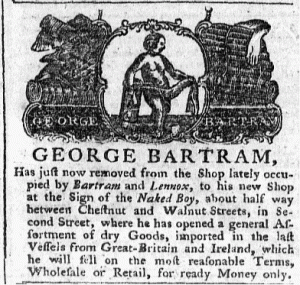What was advertised in a colonial American newspaper 250 years ago today?

“New Shop at the Sign of the Naked Boy.”
George Bartram launched a new venture in 1767, opening his own shop “at the Sign of the Naked Boy” on Second Street in Philadelphia. To let both former and potential new customers know about his new location, he published an advertisement in the Pennsylvania Chronicle. Bartram promoted the “general Assortment of dry Goods, imported in the last Vessels from Great-Britain and Ireland,” but he did not confine himself to merely describing the goods he stocked. Instead, he included a woodcut that featured some of the textiles he imported and hoped to sell to consumers in the port city. A cartouche in the center depicted a naked boy examining a length of cloth, encouraging potential customers to imagine themselves inspecting Bartram’s merchandise. That the boy held the fabric close to his naked body suggested quality and softness, enticing readers to anticipate the luxurious pleasures that awaited them at Bartram’s shop. Many rolls of fabric flanked the central cartouche, testifying to the “general Assortment” of merchandise. What kinds of tactile sensations might shoppers experience when they compared the weave of one fabric to another? The naked boy surrounded by textiles of all sorts invited colonists to visit Bartram’s shop, where they did not need to confine themselves merely to window shopping but could indulge their sense of touch as well as sight.
The woodcut also included the proprietor’s name on either side of the cartouche, an unnecessary flourish in an advertisement that featured Bartram’s name as a headline. Its inclusion may have been necessary, however, if the woodcut doubled as an accurate representation of the “Sign of the Naked Boy” that marked Bartram’s shop. The shopkeeper had previously conducted business at a “Shop lately occupied by Bartram and Lennox.” To mark his new shop as exclusively his own, Bartram may have instructed the painter or carver who made his sign to include his name as well as the device he intended to serve as his brand. Eighteenth-century advertisements regularly indicate which shop signs marked which businesses, but few of those signs have survived. Woodcuts like the naked boy in Bartram’s advertisement suggest what colonists may have seen as they traversed the streets and visited retailers and artisans who used signs to mark their businesses.

[…] in another advertisement in the same issue of the Pennsylvania Chronicle just happened to do so. For nearly three years, George Bartram had occasionally published advertisements that included a depiction of his “sign […]